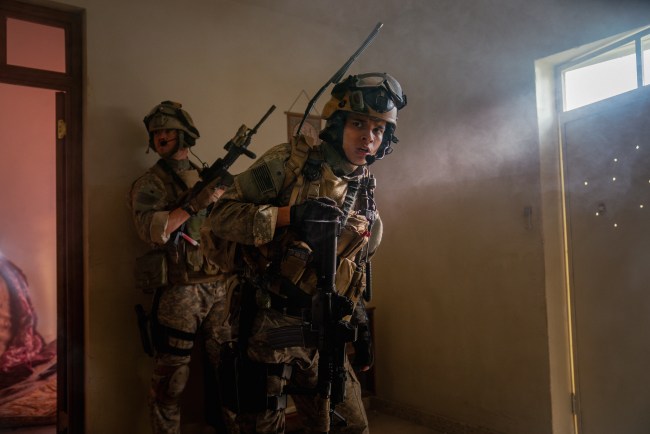While finishing “Civil War,” sound designer Glenn Freemantle and supervising sound editor Ben Barker were informed by director Alex Garland that his next film — “Warfare” — based on a real-life mission in Iraq, would be even smaller and contain no music. They were all in. But little did Freemantle and Barker realize what a subjective and immersive sound experience they were in for.
The passion project of Iraq vet Ray Mendoza, who served as military advisor on “Civil War,” “Warfare” recounts the enemy surveillance mission that Mendoza was on as a young Navy SEAL communications officer that turned into an Al Qaeda ambush in Ramadi, Iraq, in 2006. Writing and directing with Garland, Mendoza took a uniquely forensic approach to the harrowing 24-hour ordeal, relying on the collective memories of everyone involved to achieve visceral authenticity.
“We just knew it was an absolute, brilliant opportunity for us,” Freemantle told IndieWire. “Everything was going to be realistic and in real-time. We really looked forward to going down to the set. It was a great atmosphere. It was complete military mode all day, every day, even during breaks. So you knew how it was gonna be.”
Filmed north of London in a studio set recreation of the apartment building where the platoon was deployed, “Warfare” was shot chronologically with the camera running in blocks of 12-minute takes. The platoon was taken by surprise by Al Qaeda operatives next door. The soldiers were first hit by a grenade hurled through a sniper hole in the wall, and then an IED exploded outside the building, gravely injuring medic and sniper Elliott Miller (Cosmo Jarvis), to whom the movie is dedicated, and leading petty officer Joe Hildebrand, renamed Sam (Joseph Quinn). From there, the platoon has to hold on for reinforcements to help them evacuate from the building.
Freemantle and Barker had many conversations with Mendoza about the sounds of the gunfire “Everything was real and the knowledge we got from Ray was unbelievable about how their perception of sound was, their perception of the bullets,” Barker told IndieWire.
“Like the snap that you hear was really important,” Freemantle added. “Because they hear the snap before they hear the bang. Ray was very specific about the sound of the snap, which was the bullet passing overhead, and that was his sound memory.”
“And Ray’s team are reacting to that snap sound,” added Barker. “And you’ll hear it quite a lot during the film. And whenever there’s a snap, they would then turn and fire and fire and fire. And that would be the key. So whenever there’s a volume of fire from the U.S. troops, that’s when they were moving. It was always short, sharp taps of the weapon.
At Mendoza’s request, they provided realistic sound effects that were piped in through the PA system during the shoot to enhance the realism for the actors. “On the first few takes [Mendoza and Garland] didn’t let them know that the shots or bangs or explosions were going to happen,” Barker said.
Freemantle and Barker went to Czechoslovakia to shoot live rounds of ammo, piecing together every separate element within the gunshot. They shot live ammo through metal doors and through walls. “Everything was how it should be and the sounds of the airplanes coming above and firing,” said Freemantle. “We actually had previous recordings of the correct jets, so we were lucky to use those sounds again. But from Ray’s memory was the sound of the sonic boom. That’s when you really feel the impact of that noise. And Ray said, ‘I think that sound is slightly a bit too early.’ From his perception of where they were, it was right down to those sort of details.”
It all began with the surprise of the IED explosion in the apartment. This was the concussive blast that set the warfare in motion. Each soldier responded differently like they were in their own individual fog of war.
“Again, Ray gave us such knowledge: a grenade had a certain crack sound or a bigger boom sound for the IED,” Freemantle said. “So we got good insight into how that sounded. And then we started to build up different layers to do that. So it was getting that really tight sound on the IED impact, the metal, and the phosphorus. And the weight, how the sound wave would hit them, and the air pressure as well, not only in that moment, but it was also when the guns fired.
“The perception of how they heard these things was quite interesting,” Freemantle continued. “So doing it from the perspective of not just seeing into the film but how each one perceived things as it was happening, was part of a massive thing.”
In terms of the mix (particularly for Dolby Atmos and IMAX), it was a special immersion in which every sound was created with precision and accuracy. In fact, there’s one scene where Mendoza is overwhelmed by the radios coming on all at once while they’re under attack. “They’re on the left, then right, left, right, left, right,” Freemantle said. “Basically, it’s from inside his ears and it’s driving him insane.
“You can say there’s no music, but that moment does a musical thing,” Freemantle continued. “It carries you with those radios flying around and everything to that moment of silence again. That took a long time to get to that point. And a lot of work beforehand to get those radios to work.”



